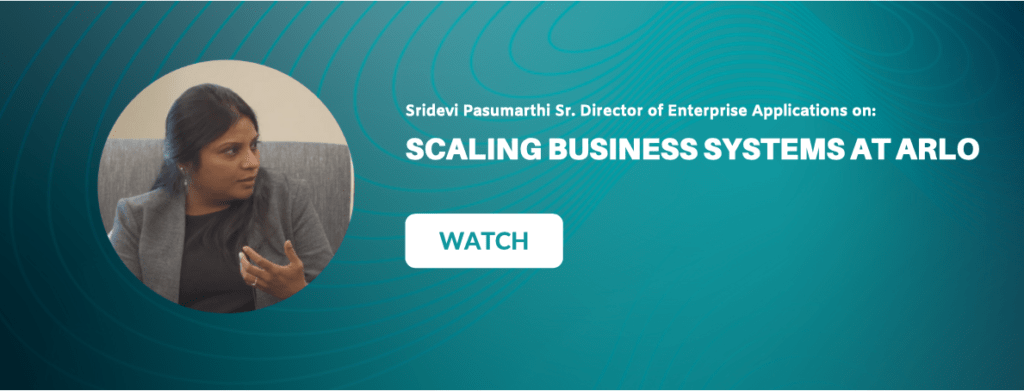This piece is part of our Digital Change Agents Series – Bay Area branch.
In February of 2018, Netgear announced it was spinning off its Arlo division of connected security cameras into its own business. At the end of the process there would be two publicly traded independent companies completely independent from each other.
While Netgear was a multinational, mature networking company built for profitability, the four-year-old Arlo was built for growth. And those two different organizational realities presented very unique challenges for Sridevi Pasumarthi, Arlo’s Director of Enterprise Applications and one of the business systems leaders responsible for helping Arlo’s lines-of-business make the transition from a division within Netgear to an independent company.
The challenge facing her team: migrate 158 business critical apps and systems across the enterprise to new instances and infrastructure. Everything from SmartSheets to the largest ERP and CRM systems would need to be audited, evaluated, and have a process created for getting it into Arlo’s infrastructure with minimum disruption to the business, maximizing the ROI by enabling a right-sized systems portfolio, and ensuring complete system separation within eight months.

Watch Sri’s full presentation >
Many systems would either be replicated and cloned, some would be discontinued, and others might be replaced, Pasumarthi says.
“It took an extraordinary level of detail planning,” Pasumarthi said. “I had an Excel spreadsheet with 170 tabs on it,” she says. To ensure a smooth transition for the business, her team created detail plans for every process, including a communications plan, change management, implementation, a SOCS-compliant and audit-compliant plan, and they even set up a 24/7 war room to manage not only the transition, but also the immediate go-live.
This incredible level of structure and planning left no stone unturned, no matter how small. Plus, high-levels of over communication resulted in a complete success for Pasumarthi and her business systems teams.
Pasumarthi shared her experience as part of Workato’s monthly Digital Change Agents series, which brings together business systems professionals across industries and companies for an intimate fireside chat on how they are driving change within their organization. Attendees not only learn expert advice and actionable insights from some of the most accomplished business systems leaders, but also benefit from growing their network of like-minded professionals.
To complete a smooth transition, those 158 apps and services were organized and grouped into specific work streams such as core infrastructure, cloud operations, engineering services, analytics, security, integration services, core applications, and customer engagement. Then Pasumarthi and team mapped out which of those work streams would migrate to the new infrastructure in a given month, taking into account all the key dependencies and challenges each migration would require to overcome.
“It’s really about managing risk in a project like this,” she says. “There were lots of moving parts to ensure all this went right, but structure, planning, and collaboration are key to this transition or any.”
As part of that transition, there were two applications and systems that were replaced with new ones out of the 158: the planning system and the help desk system.
Pasumarthi says that was a deliberate choice. “The help desk system team wanted something that was more employee friendly and easy to use. With the planning system, we knew Netgear’s legacy system wouldn’t work because of the silos it created. We knew we needed an integrated planning tool something that would allow marketing, sales, technology services, and finance, to all talk the same language and be on the same platform.”
More broadly, though, business systems teams will always have transitions and projects both big and small as they innovate and serve their customers. The only way to effectively bring about the right kind of change with the organization is to apply rigorous planning, Pasumarthi says.
Arlo Technologies has 45 percent market share in the home automation and wireless security camera space, competing against much larger companies like Amazon and Google’s Nest line of cameras. It now has more than two million registered users and has surpassed $350 million in annual revenue. Much of its success can be attributed to a strong business systems team.
“What works for 3,000 people doesn’t always work for 300,” says Pasumarthi, who is responsible for financial systems, CRM, development platforms, integration services, subscription services, e-commerce, and analytics.
“Business systems are the DNA of a company,” she says, noting that business systems teams deliver value to companies by first keeping the lights on and providing business continuity. But, then they have a real opportunity to be an influencer and bring innovation to the table “because we work across teams and see how everything fits together.”
The next Digital Change Agents event is in San Francisco featuring Fastly’s Brian Flood on March 29th.
Register here to attend in person for more insights like these >
For those not in the San Francisco area but still interested, register to watch the live-stream >
